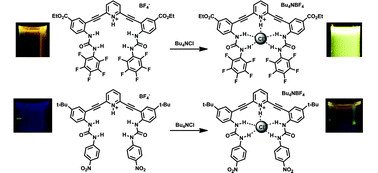Synthesis and optoelectronic properties of 2,6-bis(2-anilinoethynyl)pyridine scaffolds†
Abstract
A series of sixteen bisphenylureas based on a 2,6-bis(2-anilinoethynyl)pyridine scaffold have been synthesized for use as potential anion sensors. Prior work with one of these receptors revealed a distinct fluorescence response in the presence of a suitable anion source with specificity towards chloride anion. This study demonstrates that the fluorescent properties of these receptors can be tuned through the systematic variation of the pendant functional groups.


 Please wait while we load your content...
Please wait while we load your content...